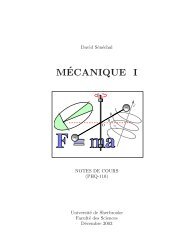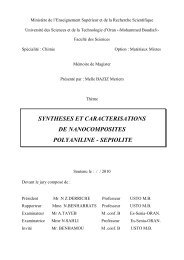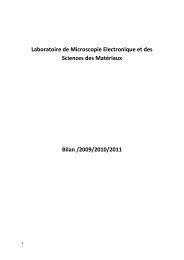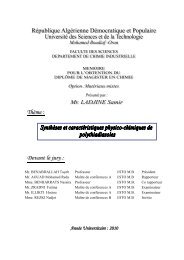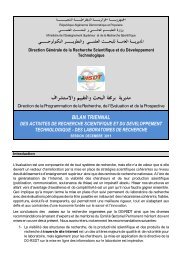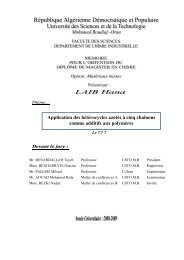Le livre des resumes - Université des Sciences et de la Technologie ...
Le livre des resumes - Université des Sciences et de la Technologie ...
Le livre des resumes - Université des Sciences et de la Technologie ...
You also want an ePaper? Increase the reach of your titles
YUMPU automatically turns print PDFs into web optimized ePapers that Google loves.
STOP FEU, Oran 2010 Posters Thème V<br />
P.5.1<br />
Physical properties of polymeric matérials<br />
N.Berrahou, M.O.Bensaid, S.Hiadsi<br />
Laboratory of the Electronic Microscopy and Materials Science<br />
Physics Department-faculty of Science USTO. BP .1505 El M’Naouar, 31100 Oran,<br />
Algéria :E-mail: berrahounoria@yahoo.fr<br />
The structures and properties of polymer melts at various interfaces have been the<br />
subject of numerous studies in recent years due to the critical role p<strong>la</strong>y in such<br />
important polymer applications.Computer simu<strong>la</strong>tion has become a major tool in<br />
polymer science in the same way as analytical theory and experiment. Consequently,<br />
the <strong>de</strong>velopment of appropriate m<strong>et</strong>hod of simu<strong>la</strong>tions for the polymers is a field of<br />
active research. These m<strong>et</strong>hods allow to investigate the propertiesof the polymer un<strong>de</strong>r<br />
different conditions such as in solution, in a polymer melt or in the crystalline state. In<br />
our work we have simu<strong>la</strong>ted by molecu<strong>la</strong>r dynamics m<strong>et</strong>hod, two polymer chains in<br />
their amorphous state , (poly m<strong>et</strong>hyl m<strong>et</strong>hacry<strong>la</strong>te) PMMA and (poly m<strong>et</strong>hyl acry<strong>la</strong>te)<br />
PMA using different force fields PCFF, COMPASS, AMBER, to view their g<strong>la</strong>ss<br />
transition. Given a simu<strong>la</strong>ted difference in Tg b<strong>et</strong>ween the two chains in agreement<br />
with experimental data. Energy studies have been un<strong>de</strong>rtaken to un<strong>de</strong>rstand the<br />
reasons for this discrepancy. The first study showed an energy difference mainly<br />
attributable to differences in intermolecu<strong>la</strong>r interactions and opening angle intra-dyad.<br />
These observations may exp<strong>la</strong>in the observed difference in Tg b<strong>et</strong>ween the two<br />
polymers. Thus the difference in results b<strong>et</strong>ween the force fields used.<br />
Keywords: polym<strong>et</strong>hylm<strong>et</strong>hacry<strong>la</strong>te; polym<strong>et</strong>hyacry<strong>la</strong>te; molecu<strong>la</strong>r dynamics; g<strong>la</strong>ss<br />
transition; force fields<br />
References:<br />
[1] Kuter Bin<strong>de</strong>r, Monte Carlo and Molecu<strong>la</strong>r Dynamics simu<strong>la</strong>tion in<br />
Polymer Scienc, Oxford University Press 1995<br />
[2] Mesfin Tsige ,P.L.Taylor ,Physical rewiew E,Vol 65 , 2002 , p- p 021805<br />
[3] Ash BJ, Siegel RW, Schadler LS. Macromolecules .Vol 37, p-p.1358, 2004<br />
[4] E. Rudrik, J. Thermal Analysis, Vol 49 , p. 465-469, 1997<br />
[5] A.Sol<strong>de</strong>ra, N.M<strong>et</strong>at<strong>la</strong>, j .Molecu<strong>la</strong>r Design, Vol 4, p.721-736 2005<br />
[6] E Osawa,KB.Lipkowitz, Reviewsin computational chemistry,Vol 6,p 6,1995<br />
[7] A.Sol<strong>de</strong>ra, N.M<strong>et</strong>at<strong>la</strong>, j .Composites.PartA, Vol 36, p 521-530, 2005<br />
[8] A.Sol<strong>de</strong>ra, Polymer, Vol 43, p-p 4269-4275, 2002<br />
60



